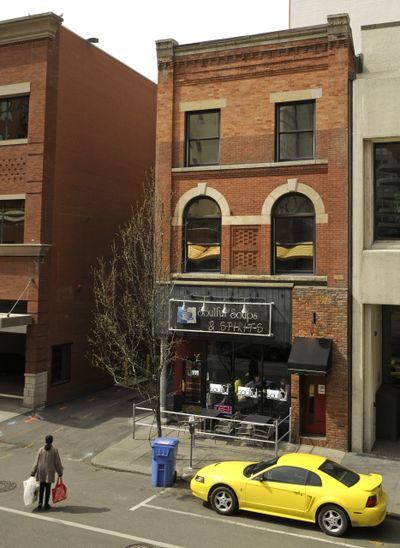Old downtown SRO hotel dates to boom of 1890s

During Spokane’s early days, the central business area was populated by many single-room occupancy hotels to accommodate the burgeoning numbers of individuals flocking to the area to seek employment. Most of these hotels provided rooms on the upper floors and retail space at street level.
Typical of these is the Woodward Building at 117 N. Howard St., which stands today as one of the few commercial buildings remaining from the building boom between 1890 and 1893 in the aftermath of the 1889 great fire that consumed 30 blocks of Spokane’s central district. Some 500 buildings went up during this period, and the Woodward Building, erected in 1890, is one of about two dozen still standing.
It’s a little unusual in that it is narrower and smaller than many of the SROs of its era. Rising 40 feet, the three-story brick masonry building with decorative parapet, pressed brick veneer, arched second-story windows and a Romanesque Revival-influenced symmetrical façade faces east on Howard Street and is probably most recognizable to the public as the home of Soulful Soups, the main-floor tenant of the building. The new occupant in the upper floors is Lululemon, a high-end sports apparel store.
The history of the building is outlined in detail by Linda Yeomans of Historic Preservation Planning, who did the research that qualified the structure for the Spokane Register of Historic Places in 2002. The building’s story is typical of so many that no longer stand, of buildings that evolved in use to meet the needs of a growing population and are players themselves in the story of the city and region’s development.
It was designed by Herman Preusse, one of Spokane’s most prolific architects, for Minnesota real estate investor Lafayette Woodward and served as a furnished SRO hotel until 1941. During its first 50 years, assorted saloons, markets, cafes and restaurants populated the first floor. The first saloon occupant was the Howard Saloon, followed by the Duffy and Hill’s Saloon, Duffy and Butler’s Saloon, Butler and Tibballs Saloon and the 117 Bar.
Architect Preusse was also responsible for the Fernwell, Great Eastern/Peyton and Bodie/1889 buildings and, in partnership with architect Julius Zittel, designed many others, including Gonzaga University’s Administration Building, St. Aloysius Church, Holy Names Academy and Our Lady of Lourdes Cathedral.
In the book “Exploring Spokane’s Past: Tour of Historic Sites,” a passage notes that New York writer Hamlin Garland came to Spokane in 1897 to absorb Western color for his writing. Apparently a Texan came out of Duffy and Butler’s and shot two elderly men. A marshal shot the still-firing Texan. The New York writer emerged from the hotel shortly thereafter with luggage in hand. And when asked if he’d seen the shooting, he replied that not only had he seen it … “I darn near felt it. Those bullets were bouncing all over the lobby.” Seems Garland took the next train back to New York.
Another interesting element in its history, according to current building owner Greg Jeffreys, is that the building apparently also housed a bordello for a period of time.
In 1911 the main floor was leased to the Tsar Theater Co., changing the name to the Isis Theater, and showed “modern moving pictures” there until 1914. The following year began a 35-year run of food service businesses – and included such businesses as Michael Guidotti Meats, the Carolina Café, Woodworth’s Café and the Hil-Mar Dinette. In 1950, the first floor was leased to Leon’s Shoe Store, which operated there until 1960, and was later home to Paul’s Men’s Shop, Beaute Fare Imports, Four Doors East women’s clothing, Signature Club Fashions and Bridal Collections. Street Music occupied the space from 1995 to 2000, after which Soulful Soups set up business there.
The upstairs SRO rooms operated under the names Crystal Hotel, Kingston Hotel, State Hotel and Moose Hotel until 1941, when the spaces sat vacant. In 1947, the American Shanghai Club leased the upper floors (for $150 a month) until 1960. After a few more years unoccupied, the second and third floors were remodeled into office space and were occupied by assorted tenants, including Tan Brookie Kundig Architects and OneEighty, a communications business.“I love this old building, the nostalgia of it,” Jeffreys said. “I think it will always be there and perform well. It’s a great location in the heart of things.”